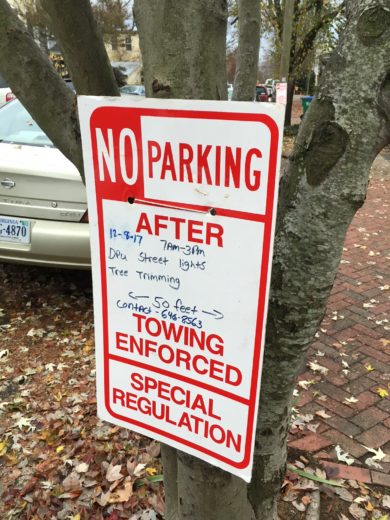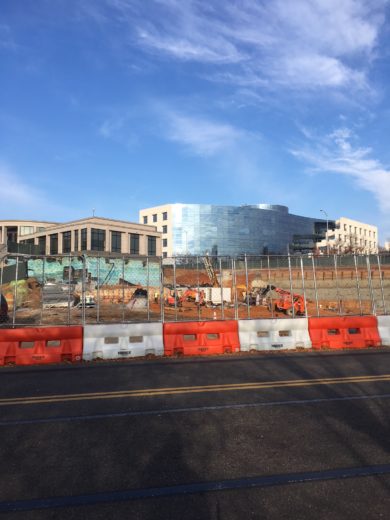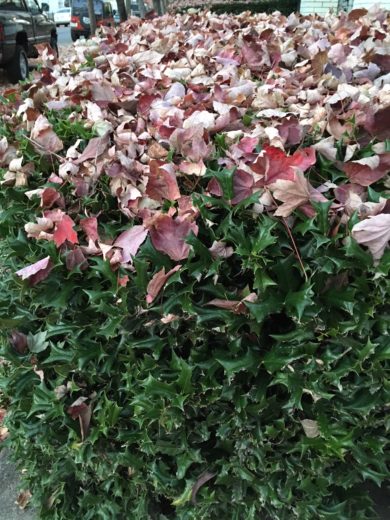Bagels, again this Saturday….


Bagels, again this Saturday….

This may be too late for some folks, but some streets have ‘No Parking’ signs up for tree trimming…

Excerpts from VCU Commonwealth Times article:
VCUarts adjunct professors will stage a day of action Dec. 8 to demand fair pay from the School of the Arts. They plan to hold a rally at the Compass, deliver a petition with more than 900 signatures to the Board of Visitors meeting and demand to have their wages raised for the upcoming semester.
An estimated 120 adjuncts in the No. 1 public art school in the country currently make $750 to $850 dollars per credit hour taught. They are capped at teaching two classes per semester, which means they would make an estimated $9,000 to $10,200 per year, before taxes.
The federal poverty line in the United States sits at $12,082, according the Census Bureau.
—
For example, in the 2016-2017 academic year, the school had a total budget of $33,659,043. Of that, VCUarts allocated more than $32 million on educational and general expenses. The school distributed $890,000 of restricted university funds, which consist of gifts to the particular departments, investment earnings and more throughout the school.The organization argues the school should use other funds in the school to properly pay their adjunct faculty rather than turning to raising student tuition.
The organization presented Brixey and other VCUarts administrators with research examining the average cost of living in Richmond and the federal poverty line in the United States — this led them to their suggestion of $2,000 per credit hour taught for adjuncts.
According to Trepanier, Brixey said the school will raise adjunct pay to $1,000 per credit hour for the upcoming semester by tapping into reserve funds, per approval from the Board of Visitors. However, it was never clarified whether the funds were primarily from VCUarts or from the university.
—
“This is an urgent crisis. The Dean is moving into a new house, but there are a lot of adjuncts that have been homeless within the last year,” the adjunct said. “When we’re talking about equity issues, we’re not just talking about what’s fair and unfair, we’re talking about someone’s life and where they’re going to sleep at night.”The adjunct also raised the concern of not being able to dedicate enough time to students because of the various jobs art adjuncts often work to pay bills.
“In terms of budgeting time, when a lot of us are working three jobs or have to drive to Virginia Tech the next day to teach, a lot of that does take a toll on the classroom,” they said. “I don’t think it’s fair to the career development of the students.”
Trepanier spoke out because she does not plan to return to VCU after her contract ends in December. She also has other forms of income she relies on, but said that’s not that case for all of her colleagues.
“People are terrified to speak up because they don’t want to lose that little bit of income that they do have,” Trepanier said. “If you eventually want a full-time job, and you go on record and they see that out on media, then schools won’t hire you because you’re a troublemaker.”
From FaceBook event page:
What: VCU Adjunct Fair Pay Rally and petition drop
When: 9am December 8th, 2017
Where: In front of the VCU Cabell Library (bring signs, wear t-shirts) From the front of Cabell Library we will walk as a group and deliver the petition to the VCU Board of Visitors.
If you haven’t signed the petition yet please do so at https://actionnetwork.org/petitions/vcuarts-adjuncts-deserve-fair-pay
This Wednesday is a “Red Wednesday”, which means trash and recycling pickup. Ideally, rolling recycling containers are stored and deployed in the back alleys along with trash cans. Please make sure you pick up containers after pickup tomorrow night.
If you have not done so already, don’t forget to sign up for your Recycling Perks.
In order to take your recycling to the next level, read this: 10 ways to improve your recycling.
The biggest and most important recycling story as of late is the new report issued by the Southern Environmental Law Center that shows Dominion can recycle its coal ash waste. Of course, corporate neighbor Dominion would rather do the cheapest, quickest option and bury it, never mind the risks to everyone’s water.
Here’s the executive summary:
Dominion Energy Virginia stores approximately 30 million tons of waste coal ash in impoundments at four different sites in Virginia: the Possum Point Power Station (Dumfries, Va.); the Chesterfield Power Station (Chester, Va.); the Bremo Power Station (Bremo Bluff, Va.); and the Chesapeake Energy Center (Chesapeake, Va.). The Virginia Department of Environmental Quality has documented the presence of coal ash-associated contaminants in the groundwater at each of these sites. In 2017, the Virginia General Assembly passed Senate Bill 1398 instructing the utility to assess the feasibility of excavation and the beneficial reuse of legacy ash for use in concrete as a mechanism for closing the impoundments at each of the four sites. This report examines the technical feasibility and market conditions for recycling impounded coal ash for use in concrete in Virginia.
Technology currently exists at commercially available levels to excavate, recover, and beneficially use legacy coal ash stored in impoundments in Virginia for concrete. Similar efforts in the nearby states Maryland and South Carolina have demonstrated success excavating, recovering and beneficially using coal ash in encapsulated beneficial reuse applications to manage and close legacy impoundments. As of 2015, approximately 1.5 million tons of impounded ash from the R. Paul Smith Landfill has been beneficially used in the cement industry, currently at a rate of 450,000 tons per year (TPY). It is expected that complete excavation of all ash will occur by 2020. In South Carolina a Staged Turbulent Air Reactor (STAR) facility became commercially operational at the Santee Cooper Winyah Generation Station in 2015. The 400,000 TPY facility was constructed to process impounded ash into a high-quality, specification grade product for the concrete industry. Three additional 300,000 TPY STAR facilities are planned for construction in North Carolina in 2018 and 2019. These facilities will be located at Duke Energy power stations with totals of 6.2, 6.4, and 5.7 million tons of legacy ash. Collectively, the proposed North Carolina facilities will process 900,000 tons/year. Construction costs for the facilities have been estimated at approximately $50 million each, while the price of high quality, specification grade ash materials, on the order of $50/ton, contributes significantly to the financial viability of this approach.
Coal ash has a long history of use in concrete applications because it increases the durability and strength of the final product. The first major domestic project using coal ash as a concrete supplement was repair of the Hoover Dam in 1942. Today, the recycling of impounded ash at Dominion’s power plants will supply a critical construction material to the industry that builds and maintains transportation infrastructure in Virginia and the southeast region. Nationwide, coal ash is used in 75% of all concrete used for transportation projects, significantly reducing project costs. The Virginia Department of Transportation estimates that fly ash is used in 60 to 70% of all concrete used in transportation projects in the state, all of which, to the best of our knowledge, is currently fully sourced outside of the state due to the lack of beneficiation facilities operating in Virginia. Demand for processed, impounded ash is expected to increase as coal fired power plants are shuttered or switched to other fuels. The overall demand for coal fly ash in Virginia is estimated to be 16 million tons from 2015-2030 and 46 million tons for Virginia, North Carolina, and South Carolina collectively during this period. The beneficial use of impounded coal ash for concrete from Dominion’s power plants will produce multiple benefits for Virginia.
First, it will eliminate the long-term risk of groundwater and surface water contamination and eliminate the utility’s liability for that contamination. Given the record of contamination from the Dominion sites and their location adjacent to waterways, these unlined legacy coal ash impoundments may continue to contaminate state waters with coal ash constituents even when capped with an impermeable cover. Second, beneficial use will create jobs to support an industry that is not currently operating in Virginia, and also generate tax revenue. And third, beneficial use will provide increased competition for a high value product, lowering state funded construction costs and limiting the import of foreign ash into the state. Based on the data collected for this report, the beneficial use of impounded coal ash for concrete is a feasible, cost effective alternative for cleanly closing legacy ash ponds at Dominion Energy Virginia power stations.
Technically, N.Pine is north of the neighborhood, but relaying this information anyway.
From CommunityCrimeMap.com:
BURGLARY/B and E/RESIDENTIAL
1XX N PINE ST
Dec 1, 2017 at 1:15 am
Data provided by Richmond Police Department
On a related note, on Sunday a Laurel Street neighbor watched a guy with a package walk into an unlocked house across the street. He walked back out quickly and went back in the direction he came from toward Idlewood St. The owner of the home popped up and yelled after him “Did you need help with something” and he said he yelled back he got the wrong address but he kept moving. The owner then told us that he seemed startled by her dogs when he came in and she thinks thats why he left so quickly.
She was advised to report the incident to the police.
There’s another powerful movie event Wednesday at the main branch of the Richmond Public Library.
From FaceBook event page:
The Richmond Public Library, Bijou Film Center, and CodeVA are holding a very special, family-friendly celebration of Computer Science Education Week (Dec. 4-10) with a free public viewing of the acclaimed film, HIDDEN FIGURES.
Virginia, the Digital Dominion, is home to many “hidden figures” in Computer Science – both past and present. Computer Science Education Week each year also marks the birthday of Admiral Grace Hopper, a Navy officer, WWII hero, and longtime Virginia resident who invented the first computer compiler and discovered the first software “bug.” It is also home to NASA Langley, where the heroic human “computers” depicted in HIDDEN FIGURES worked to launch America ahead in the Space Race.
Come early for a special speaker panel discussing the important roles Katherine Johnson, Mary Jackson and Dorothy Vaughan played, not only in manned spaceflight, but also in helping launch modern computer science.
Worried about dinner? We have that covered! There will be pizza, popcorn and Tang!
Panel discussion starts @ 5:30PM
Movie starts @ 6:00PM
These photos were taken yesterday of work on the Virginia War Memorial, along 2nd Street.


It’s a nice day, but much cooler weather is coming later this week.
Please take the time to clean leaves off the sidewalks. When snow and ice do arrive, they will become especially treacherous.

From Times Dispatch article:
Open
Plan A: A complete renovation/replacement would be done starting in fiscal year 2027.
Plan A cost: $5.6 million ($559,723 in 2027; $3.9 million in 2028; $1.1 million in 2029)
Plan B: A complete renovation/replacement would be done starting in fiscal year 2027.
Plan B cost: $5.6 million ($559,723 in 2027; $3.9 million in 2028; $1.1 million in 2029)